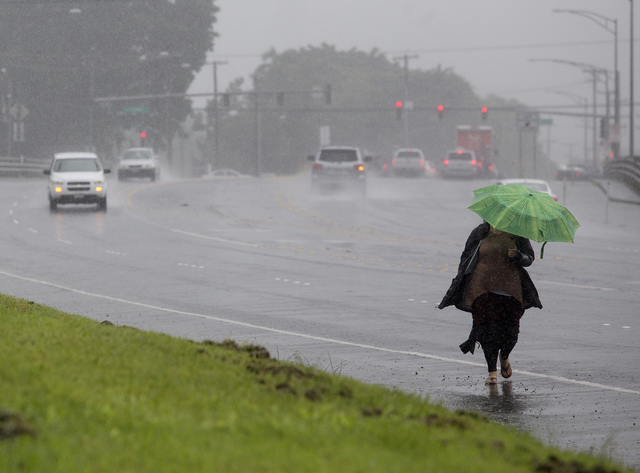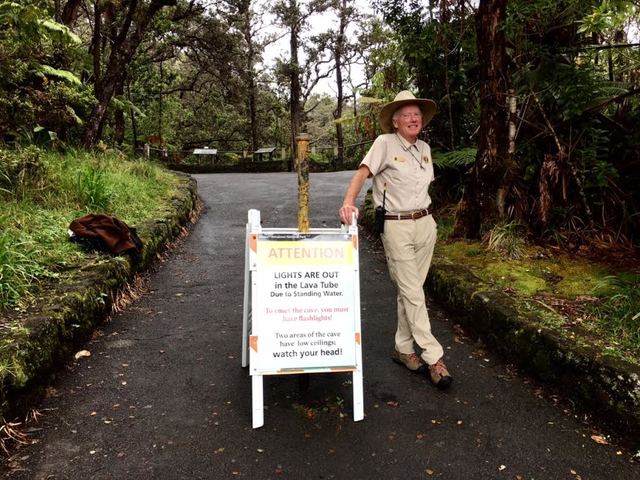Moisture to continue … but not as heavy as last week
Pahoa likely received more than a foot of rain in the past five days and Hilo nearly a foot.
ADVERTISING
National Weather Service meteorologist Derek Wroe said a reporting station atop Saddle Road received the highest rainfall total, with 15.65 inches falling between Dec. 1 and Monday.
Pohakuloa Training Area, though, only received 1.59 inches during the same time period, illustrating how variable the rainfall totals were from place to place.
Hilo International Airport, he said, got 11.85 inches and Pahala received 8.95 inches. Mountain View got 9.54 inches and 10.72 inches fell in Glenwood.
Rain will continue for the next 10 days throughout East Hawaii, but it will be less widespread and not as heavy.
“So far, it’s looking like things are holding and possibly lightening up just a little,” said Jessica Ferracane, spokeswoman for Hawaii Volcanoes National Park.
Although rainfall predictions are difficult to make, NWS forecaster Pete Donaldson said from Honolulu that wind patterns will trigger more afternoon rainfalls instead of the typical overnight ones. Those rains likely will be less torrential than last week’s 3 inches to 4 inches per hour, a rate which was reached in several areas.
Instead, Donaldson said, winds will be light with less-bountiful rain, although some spots could still see locally heavy downpours.
Donaldson said sea breezes during the daytime, along with cloud breakup, will create conditions favorable for afternoon rains. He expects a return to heavier precipitation amounts after that initial 10-day period of relative respite from heavy rains.
He emphasized that forecasting becomes more difficult the farther out in the future it’s attempted.
“Off in the future, past the end of this work week, it gets a little harder to tell,” he said.
Ferracane said Mauna Loa Road, which takes hikers to the path leading to Red Hill Cabin, remains open. But the trail itself is closed beyond the cabin.
She said one driver estimated 150 4-wheel-drive vehicles were lined up during the weekend, with drivers hoping to reach snow level via Mauna Loa Observatory Road (a separate route that is not within the national park’s boundaries).
“The snow-cloaked summit of Mauna Loa will remain closed to all-day use and overnight camping until it is safe to reopen,” said a statement released Monday by the national park.
Backcountry hiking permits are available only as far as Red Hill Cabin. Areas above 10,000 feet are closed to everyone.
Mauna Kea’s Visitor Information Station (which, at 9,200 feet, did not receive snow) remained open during the weekend snowfall on the summit. But the road the road to the summit leading up from the VIS was closed because of ice and snow across roads. Snowdrifts of 3 feet were reported there last week. The summits received snow above the 11,000-foot level.
Kanani Aton, public information specialist with Hawaii County Civil Defense, said much insight was gained last week.
For example, she said, county officials asked residents to stay off the roads unless they had a critical need to drive.
“We did notice that people were staying off the roads, or using alternate routes as needed,” Aton said. That made emergency response safer and faster.
“We are very appreciative of the public heeding messages,” Aton said. The requests to stay off roads and avoid camping were effective, she said, noting “that’s another lesson learned.”
She emphasized the island’s well-known refrain that people should try to stay “flood-proof, storm-ready, always packed up and ready to go.”
It’s been an unusual rainwater runoff season, Aton said, with more runoff ending up on roads and highways normal.
“It really speaks to the need for maintenance of our runoff, drainage, especially on private property,” she said. Property owners will hear directly from Civil Defense if their work affected ditches and swales purposely installed as part of runoff management.
The Civil Defense Emergency Operations Center was no longer needed during the weekend, Aton said. But administrator Ed Teixeira remained on duty in case the need arose.
Aton said clouds of steam, including glass particles and hydrochloric acid, arose Friday night from the lava flow entering the ocean at Kamokuna. It blew onto the hiking path to the observation point. That path was closed for the night Friday, and vehicles were turned away.
HVNP, which is composed of more than 383,000 acres, kept as much access open to popular destinations as it was able during the weekend, Ferracane said.
Nahuku, or the Thurston Lava Tube, “is open, but the lights are still out. Visitors must bring a flashlight to explore the 300-foot lava tube, which becomes pitch black just a few yards in without light; has uneven flooring and a low ceiling in some sections.” The tube was closed after water from heavy rains built up on the floor. Park officials reopened it, but kept the electricity turned off Monday to prevent park visitors from getting shocked.
Park rangers are stationed at the tube’s entrance and visitors are not allowed in if they’re not in possession of flashlights.
The park’s Kahuku Unit remains open for hiking on weekends.
The park quoted Superintendent Cindy Orlando reminding visitors to drive with caution and aloha.
“Roads are flooded in places, and visitors might encounter fog, additional rain and other inclement weather today and as the week progresses,” the national park said.
Email Jeff Hansel at jhansel@hawaiitribune-herald.com.




